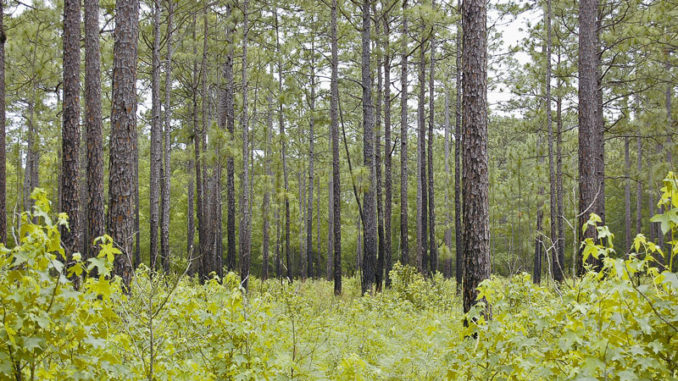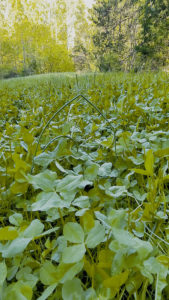
Ground-level forage is possible product of timber thinning
Deer and other wildlife species need nutrition 365 days a year, plus an additional day in 2020 because of leap year.
Rural lands across North Carolina and South Carolina remain in a semi-natural condition. Outside of the city and suburban development lies rural Carolina, bursting with agriculture fields and rolling pastures. But rural regions are glued together with forests of various age, quality and species composition. These forests need ongoing management to encourage fiber appreciation. And to promote wildlife forage availability.
Development and agriculture operations stand out. But the states’ land mass is dominated by forested land cover. In fact, 67% of South Carolina is considered in a forested state. And North Carolina is not far behind at 60%.
Wildlife intermingles in these rural and suburban habitats to make a living, utilizing both the forested and non-forested components. Of course, wildlife will venture into the open grounds to feed. But the forested regions are a critical part of the landscape for their daily survival needs. Wildlife need forests for escape cover. And forested sites provide a mechanism for maintaining protected feeding opportunities.
Food in forests
Food availability in forests is extremely variable, depending on the soil type, drainage type, species diversity and age distribution. Under the right conditions, forage availability within forested land cover can provide wildlife with excellent opportunities to sustain a healthy lifestyle. However, accessible ground forage can decline as canopy cover closes. Sunlight is vital to all plants and will be absent below the canopy when the crown of dominant and mid-story trees monopolize available beams of light.
Accessible forage availability in the understory can decline in any forest due to canopy closure. But it is highly likely in pine-dominated landscapes in pine monocultures. The Carolinas’ forested landcover is dominated by pine forests, since much of clear-cut forests are replanted in loblolly and longleaf pine seedlings soon after cutting. The growth rate and return on investment (ROI) for planted pine is much greater than any other planted species in the Southeast. As a result, pine-dominated forests will have declines in forage availability on the ground level. And much of the forested region of the Carolinas are heavy to pine.
Understory food
A reduction in understory can be a benefit for hunters, providing open woodland vistas. But a more-developed understory will provide wildlife with natural foods and low-level ground cover as well.
Luckily, forestland investors that follow routine pineland management activities will often encourage palatable understory growth as an indirect effect. Selective harvesting or thinning operations are part of any forest-management plan. And this instantly opens the canopy to allow sunlight to penetrate back to the forest floor. Sunlight penetration and disturbances along the forest floor will encourage growth of understory species.
Thinning pine stands
Thinning operations on pine-dominated forests are typically scheduled in two to three intervals. The first thinning operations begin when the trees are approximately 12 to 18 years old. The second thinning will occur six to eight years later. During each thinning, approximately one-third of the total volume is removed evenly to funnel nutrients and sunlight to the residual stems. As a result, the canopy is opened and sunlight filters to the forest floor. Mid-story hardwoods that lack beneficial wildlife value can also be removed at this time, too. Mid-story trees will grasp sunlight and shade out areas below as well.
During the thinning operation, the large machinery required to remove the timber causes enough disturbance along the ground to allow germination of understory plants. A follow up prescribed burn can also aid and speed up forage production in the understory.
When pine plantation owners avoid routine thinning, the forage base within the understory can be diminished and completely absent on some sites. Routine thinning on pine sites encourages understory growth. This growth produces cover and food to benefit deer, turkey, and a long list of small game species.
Pine plantations are the primary forest type where understory forage can vanish. Yet, hardwood stands can also benefit from selective harvests or thinning operations. Hardwood thinning can produce the same effect by opening the canopy layer to encourage understory browse. Encouraging sunlight to the forest floor can benefit both hardwood, pine-dominated and mixed forested stands.
Hardwood sun hogs
Crown closure in hardwood stands can be more dramatic than in pine stands. Hardwoods are more likely to develop large crowns. Their towering branches often extend as much as 30 feet away from the trunk. They can be major sun hogs.
When these large crowns are from white oak and red oak trees, the acorn production can be a major benefit to deer and other wildlife. A heavy thinning may not be preferred on stands dominated by acorn producers. But quite often, many of these hardwood stands are not dominated by wildlife-preferred, mast-producing trees.

Stands are usually mixed stands, with large components of pine available as co-dominant species with gum, beech, maple and poplars making up the hardwood component. Thinning in these stands dominated by hardwoods and pine-hardwood mixes can always be beneficial to wildlife on the ground level.
The primary focus of forest-management tactics may be to promote fiber production and boost the rate of return. But routine thinning and prescribed fire on both hardwood and pine stands will encourage wildlife habitat improvement through understory cover and forage production.
Boost summer perennial growth
Perennial plots are some of the rainmakers for properties big and small.. And the biggest perennial plot utilized for wildlife is undoubtedly white clover. Deer and other wildlife visit these plots on a routine basis to fulfill their daily nutritional intake.
Why wouldn’t they?
White clover is rich in digestible protein and is resistant to heavy browsing. Clover will regenerate quickly when sunlight, adequate moisture and soil nutrients are available. And certain soil elements may need replenishment during times of need.
Perennial plots such as clover can benefit from nutrient supplements in summer to give these plots a growth boost. Since clover is a nitrogen fixator, nitrogen does not need to be added to these plants. But phosphorus and potassium supplementation will directly benefit clover and other perennial plots in summer especially when growth has showed a decrease in production.
As a part of the overall management regime, triple super-phosphate (0-46-0) and potash (0-0-60) can be added simultaneously during the summer to boost production. For the best results, choose days to apply supplements when adequate soil moisture is present around normal rainfall periods to allow plants to soak up the fresh nutrient boosts.


Be the first to comment